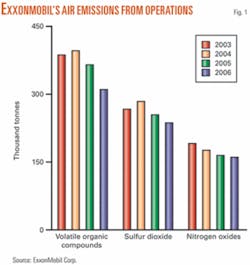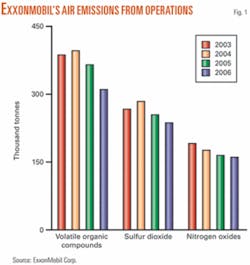Environmental stewardship and employee safety ranked high among issues major oil companies addressed in the lengthy, nonfinancial disclosures for 2006 that some companies call sustainability reports and others, corporate social responsibility reports.
Companies issue these reports in response to demand for information on corporate governance and risk-mitigation. Content varies considerably between companies and also between countries (OGJ, Oct. 1, 2007, p. 20).
Nonfinancial reporting across much of the world lacks the hard rules that governments typically provide for financial reports. Oil companies hire outside auditing firms to provide assurance on the information.
The International Petroleum Industry Environmental Conservation Association and the American Petroleum Institute jointly issued a voluntary framework in 2005. Oil companies use the IPIECA-API framework and the Global Reporting Initiative (GRI) reporting guidelines.
GRI was developed by the US-based Coalition for Environmentally Responsible Economies and the United Nations Environment Program. GRI guidelines initially were released in 2002; the latest update came in October 2006.
The following summaries show the variety of information major oil companies are reporting.
BP notes difficulties
John Brown, BP PLC chief executive until May 1, 2007, wrote an introduction to the 2006 report in which he said, “The past 2 years have been difficult for BP.”
He referred to the March 2005 blast at the Texas City, Tex., refinery as well as oil spills and pipeline corrosion problems in Prudhoe Bay, Alas.
“This year, BP’s performance on key sustainability issues related to our operations has been under intense scrutiny from governments, investors, civil society, and the media,” the report said.
During 2006, BP created two senior management subcommittees: the group operations risk committee and the group financial risk committee. The company also conducted a series of “town hall” meetings throughout BP to discuss its management framework.
“There is no sense of complacency in BP,” Brown said. “The tragic events of Texas City reminded us all of the physical danger associated with the commodities with which we work and the need for the strongest processes, matched by a universal sense of personal responsibility, in the management of risk in all our operations.”
The company plans to invest an average of $1.7 billion/year on integrity and reliability across its five US refineries during 2007-10, compared with $1.2 billion in 2005.
In Alaska, BP committed to invest more than $550 million on integrity management during 2007-08. It hired 12 additional permanent employees to support integrity-related activities and boosted the number of contractor workers for inspections and repairs.
Companywide, BP reported that the overall number of spills of 1 bbl of oil or more during 2006 decreased to 417 from 541 in 2005. The volume of oil spilled was 2.2 million l., of which 400,000 l. was unrecovered. That compared with the 2005 total of 4.4 million l. spilled, of which 1.2 million l. was unrecovered.
BP reported seven fatalities during 2006 compared with 27 fatalities during 2005. The 2006 figure was the lowest level in nearly 20 years of reporting. All seven deaths involved contractor employees.
The reported recordable injuries for 2006 fell to 0.47/200,000 hr worked, marking the lowest in the company’s recorded history.
ExxonMobil cuts emissions
ExxonMobil Corp.’s report emphasized its reduced greenhouse gas (GHG) emissions from operations and improved operating efficiencies, upstream and downstream.
It reported GHG emissions of 146 million tonnes during 2006, up 5.4% from 2005. The increase stemmed from the company’s increased oil production in Africa and increased LNG production in the Middle East.
Operations consumed 1.475 quadrillion btu of energy last year. Since 2000, ExxonMobil estimates energy efficiency savings of $750 million/year in its refining and chemical businesses.
The firm aims to improve energy efficiency across its US refining operations by 10% in 2012 as compared with 2002.
As of 2006 compared with 2003, ExxonMobil reduced air emissions from operations for sulfur dioxide, nitrogen oxides, and volatile organic compounds (VOCs) by 11-20% (Fig. 1).
Total air emissions from the Beaumont, Tex., refining complex decreased 65% in 2005 from 2000 levels. The company plans to reduce emissions a further 25% by 2008.
Developers are careful with sensitive ecosystems, the company noted. In the Golden Pass LNG project in Sabine Pass, Tex., 20 acres of wetlands will be preserved by using horizontal drilling to install pipelines underinstead of acrosswater and wetlands.
ExxonMobil reported 10 fatalities in 2006, including three employees and seven contractors. Four fatalities involved operations, three resulted from acts of violence, and three resulted from vehicle accidents.
For its total workforce last year, including employees and contractors, the total recordable incident rate was 0.377, and the lost-time incident rate was 0.049. These rates are the number of incidents per 200,000 work hours. Both were record lows.
ExxonMobil invested over $82 billion for energy production and technology on six continents over 5 years, including nearly $20 billion in 2006. Downstream, the company invests primarily in capacity expansions.
“We have effectively added a new industry average-size refinery to our portfolio every 3 years and an average-size conversion unit every year at a fraction of new facility construction costs,” ExxonMobil said.
Total’s safety culture
“Forging a strong safety culture is the critical focus of all group action plans, and a number of safety behavior initiatives have been undertaken,” Total SA said.
Total’s petrochemical plants launched a safety program under the guidance of Marcel Simard, professor of industrial sociology at the University of Montreal. The program is based on management commitment and employee participation.
“Now available to all operational managers, dedicated HSE training programs facilitate experience sharing on both technical and HR (human resources) matters,” Total said. “A shared safety culture is gradually developing in all areas.”
The company reported 18 fatalities during 2006. Eight deaths involved operations, nine involved product transportation by road and loading, and one involved personal travel by road.
All but one of the fatalities involved contract employees, said Total, which said it places “the same importance to contractor employees as we do to our own employees.”
For oil, gas, and petrochemical activities, the total recordable injury rate (TRIR) per million hours worked averaged 3.4 during 2006. This included Total employees and contract employees (Fig. 2).
Shell reports deaths
Royal Dutch Shell PLC reported the deaths of two employees and 35 contractors for a total of 37 during 2006, one more than in 2005. During 2006, 17 deaths happened in Nigeria, where nine resulted from kidnappings or assaults.
“Recently, more fatalities have been occurring away from our operations and outside working hours, where we have less oversight,” Shell said. “The number of fatal assaults, drownings, and road accidents all rose in 2006. These three causes accounted for more than 75% of lives lost.”
As a result of higher fatalities from these causes, Shell’s fatal accident rate (fatalities per 100 million working hr) did not significantly change in 2006. Shell reported its fatal accident rate has improved by more than 50% since 1997.
Efforts to change behavior and strengthen safety culture are working, Shell said. The injury rate for staff and contractors has improved by 45% since 1997. Injuries at work declined again in 2006, beating Shell’s target.
Shell also is looking to improve process safety to ensure that facilities are well designed, operated within design limits, and well maintained.
“Our exploration and production business intends to increase spending on asset integrity,” Shell said. “Over the last 3 years, nearly two thirds of our investment in the downstream business went to maintaining the reliability and safety of our existing facilities.”
Shell’s environmental accomplishments included the start-up of two monopods in the North Sea during 2006. These are natural gas production platforms powered by wind and solar electricity.
The lightweight, low-cost, zero-emission platforms stand on one leg and are based on the design used for offshore wind turbines. Each platform uses 1.2 kw/d, compared with 30 kw/d for a traditional unmanned platform or the 40 Mw/d for a full-size, manned platform.
Statoil notes emissions
Statoil ASA’s 2006 report was its last one before the merger with the oil and gas division of Norsk Hydro ASA to form StatoilHydro (OGJ, July 23, 2007, p. 34).
Helge Lund, while chief executive of the former Statoil, said the public’s concern about global warming is likely to result in tougher demands on oil and gas companies. He believes carbon emissions and global warming overshadow all environmental concerns.
The oil industry’s contribution can be technology development, he said. During 2006, Statoil constructed the Mongstad combined heat and power station and collaborated with Shell to inject carbon dioxide in Heidrun and Draugen fields for enhanced oil recovery.
Statoil reported no fatalities during 2006. Regarding operating incidents, Statoil shut down the Visund platform in the northern North Sea for 4 months following a Jan. 19, 2006, gas leak that stemmed from a design fault on a knock-out drum (OGJ, Mar. 13, 2006, Newsletter).
Company-wide production in 2006 averaged 1.135 million boed, a decline of 34,000 boed from 2005. The company plans to accelerate exploration to boost its reserve replacement rates.
“To maintain our competitiveness, we must work constantly on productivity improvements and secure long-term growth in production and reserves,” Statoil said. “Our average reserve replacement rate was 94% in 2004-06. This is not satisfactory for securing long-term growth.”
Lund noted that the energy industry faces growing demands about ethics “not only because the world has generally become more concerned with such issues, but also because people are investing more and more of their assets in pension funds.
“They want to know what they’re putting their money into. This means we’ve got to show that there’s quality and coherence between what we say and what we do.”



